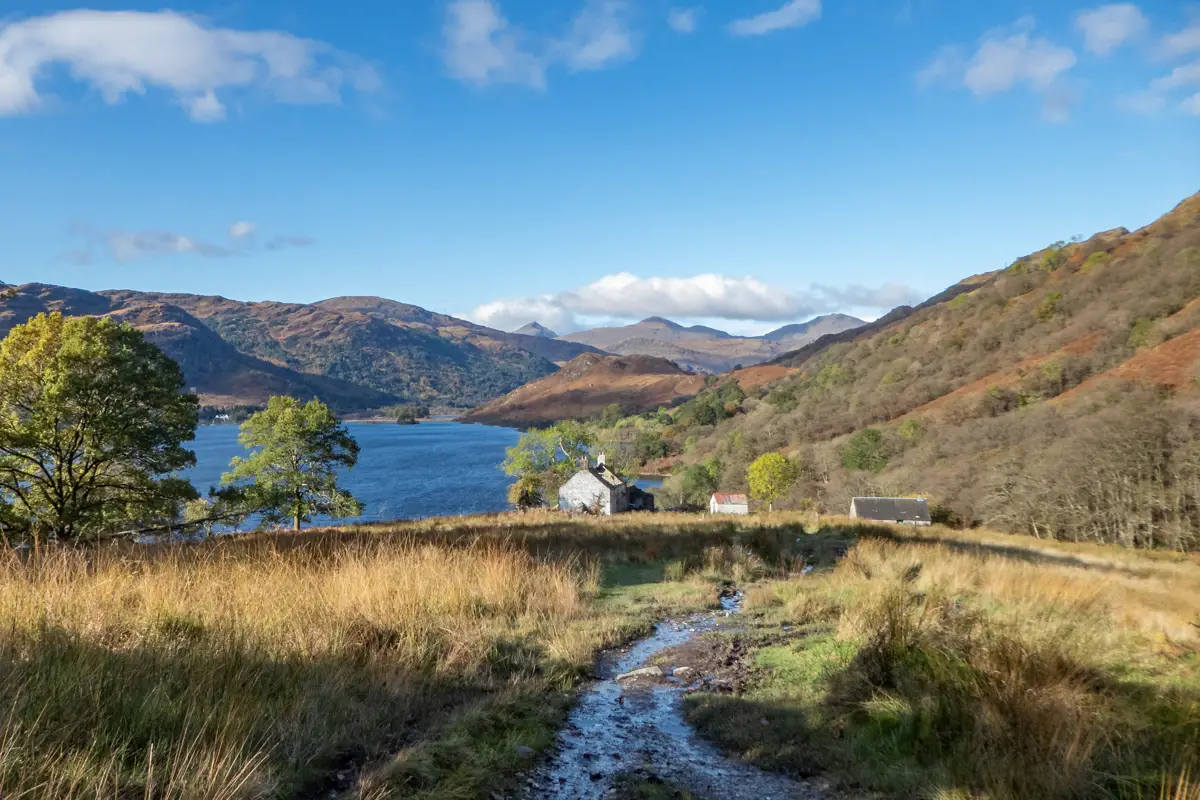The West Highland Way walk is the most popular long-distance trail in the UK. It spans 96 miles (155 km) and can be completed in anything from 13 hours and 41 minutes (that is the current record held by one runner in the West Highland Way Race!), right up to a few weeks. The most popular West Highland Way itinerary is the 7-day version but many people give themselves anywhere from 5-8 days to complete the whole hike.
The West Highland Way begins in Milngavie (pronounced Mil-guy) on the outskirts of Glasgow. It crosses some of Scotland’s finest scenery, before finishing in Fort William. If you fancy taking on the challenge of the West Highland Way but have no idea where to start, don’t worry.
I’ll outline the most popular route options based on the amount of time you have and help you choose your perfect West Highland Way itinerary.
This post contains affiliate links. If you use them, I will receive a small commission at no extra cost to you.
Read more: (opens in new tab)
- West Highland Way Vs. Great Glen Way
- Camping on the West Highland Way
- Accommodation on the West Highland Way
- West Highland Way: Packing List
Practical Information for the West Highland Way
What is the West Highland Way Route?
Should I go South to North or North to South?
This is a common question asked by those looking to do the West Highland Way. Personally, I would recommend the most popular of the two options, going South to North.
By starting in Milngavie, you’ll meet plenty of other hikers en route which enhances the feel of community along the trail. Another huge benefit is that it is probably the easier part of the trek to reach using public transport. The scenery becomes only more impressive as you head North so this route offers new and more mind-blowing views with each day.
However, there are benefits to heading North to South. Going in the opposite direction means that it will be less crowded (heading in your preferred direction at least)! Be aware that some baggage transfer companies will charge extra to transport your bags going in this direction.
When is the best time to hike the West Highland Way?
Although most people would say that summer is the best time to hike the West Highland Way, this is when the trail is at its most crowded. As a result, you may struggle to find the peace and serenity that this trail can bring. Another downside to hiking in summer is that Scotland’s infamous midges are rife. Be warned, they bite! For more about the Highland midge and how to avoid them, click the link.
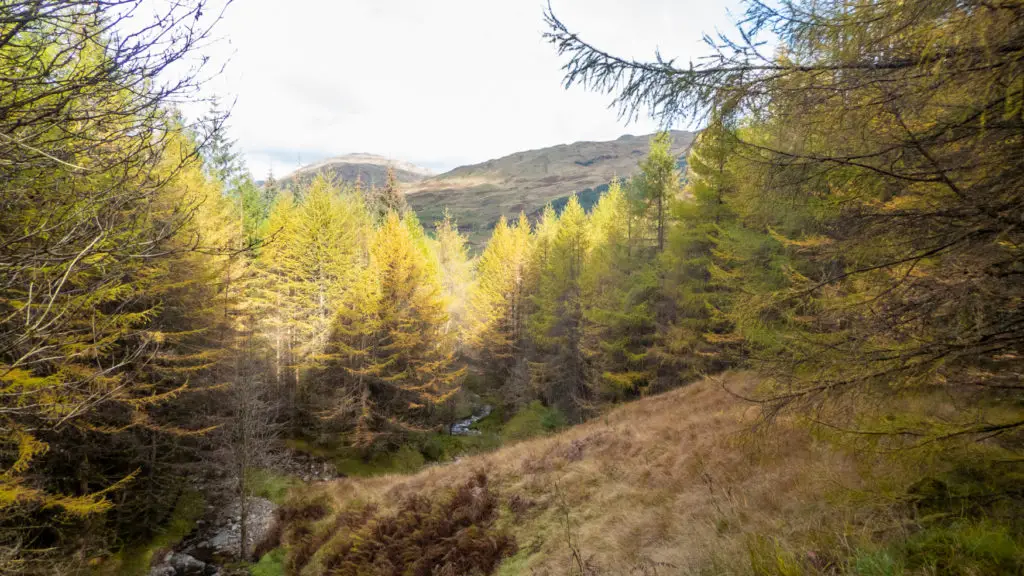
In my opinion, much better times of year to hike are spring and autumn. Although March can still be chilly, April brings pleasant temperatures. It is worth remembering to book your accommodation in advance if your hike coincides with the school half-term break.
I walked the West Highland Way in mid-October and I would definitely say this is the latest you should leave it, especially if you are camping! We had frost, flooding and a few slips getting over icy bridges. However, there is no denying that the scenery at this time of year was absolutely breathtaking.
Getting to and from the West Highland Trail
Milngavie is very easy to reach from Glasgow by train. Enthusiastic hikers may even want to start their West Highland Way journey a day early, by hiking from the city centre out to Milngavie.
Fort William is also easily reachable by train. There is a direct train (along the West Highland Line) to Glasgow which showcases some stunning scenery.
Where can I leave my car in Fort William?
There doesn’t seem to be much information about this online. You can apply in advance for a monthly permit for one of the car parks in Fort William. The one closest to the finishing point of the West Highland Way is the West End car park. Book your long-stay permit for just £10 and catch the train to Milngavie from Fort William to start the walk.
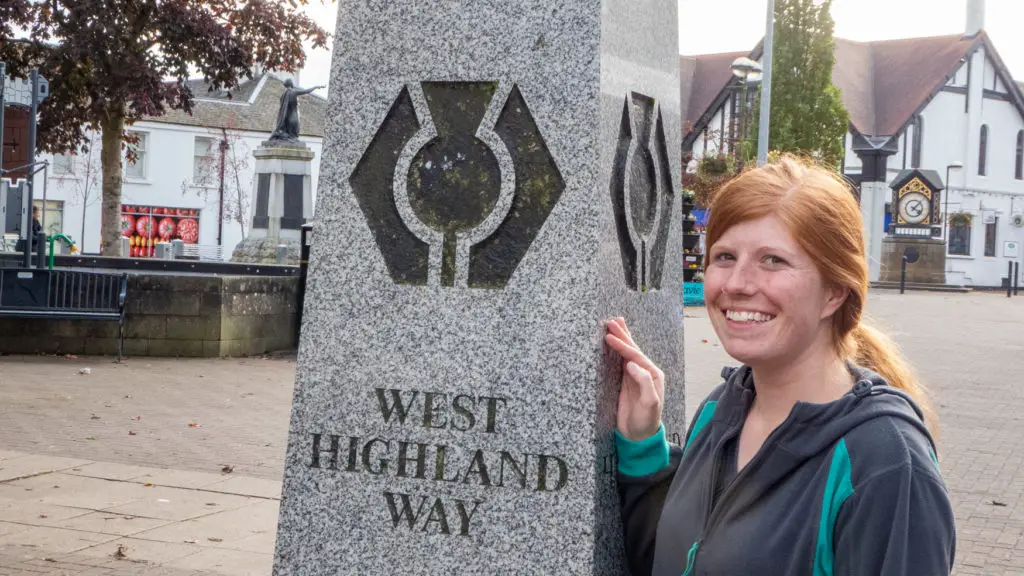
Where can I camp on the West Highland Way?
From the 1st of March to 30th of September there are restrictions on wild camping across some parts of the West Highland Way. During this time, campers must have a pre-arranged permit or stay in designated campsites. For suggested camping spots and other wild camping tips, have a read of this article about camping along the West Highland Way.
Can I stay in hotels along the West Highland trail?
There are hotels and hostels along the West Highland Way route. In peak season, these will need to be booked in advance. In the itineraries below, I have included some recommended accommodation options at each stage end.
Recommended West Highland Way Itineraries
5 Day West Highland Way Itinerary
Day 1: Milngavie to Balmaha (19 miles)
- Difficulty: Easy
- Highlights: The starting point of the West Highland Way on Douglas Street in Milngavie, Glengoyne Distillery and the views from Conic Hill.
- Facilities: Accommodation available in Milngavie, Drymen and Balmaha. Refreshments are also present at these stops along the route. You may see some honesty box systems in place along the route.
- Suggested accommodation: West Highland Way Rooms (Milngavie) & Birchwood Guest Lodge (Balmaha).
Day 2: Balmaha to Inveraran (21 miles)
- Difficulty: Challenging
- Highlights: Loch Lomond, Potential detour to Rob Roy’s Cave.
- Facilities: Accommodation available in Inversnaid and Inveraran. Refreshments also available at both stops but choice is limited.
- Suggested accommodation: The Drovers Inn (Inveraran).
Day 3: Inveraran to Bridge of Orchy (19 miles)
- Difficulty: Moderate but challenging if you are suffering from the previous day.
- Highlights: Stunning mountain views.
- Facilities: Accommodation available in Crianlarich, Tyndrum and Bridge of Orchy. Refreshments and supplies at Strathfillan, Tyndrum (the famous Green Welly) and in Bridge of Orchy (honesty shop at the station).
- Suggested accommodation: Bridge of Orchy Hotel (Bridge of Orchy).
Day 4: Bridge of Orchy to Kinlochleven (21 miles)
- Difficulty: Moderate (Rannoch Moor can be challenging in bad weather with poor visibility).
- Highlights: Rannoch Moor, Glencoe, wild Red Deer in the area around Kingshouse and the Devil’s Staircase.
- Facilities: Accommodation available at Inveronan, Kingshouse and Kinlochleven. Very few places along this stretch of the route to replenish supplies so bear this in mind in the days leading up to this stage.
- Suggested accommodation: Blackwater Hostel (Kinlochleven).
Day 5: Kinlochleven to Fort William (16 miles)
- Difficulty: Easy
- Highlights: Ruins at Tigh-na-sleubhaich, views of Ben Nevis and arriving at end of the West Highland Way in Fort William.
- Facilities: Various accommodation options available in Fort William and plenty of places to eat and drink at the end of the trail.
- Suggested accommodation: Alexandra Hotel (Fort William).
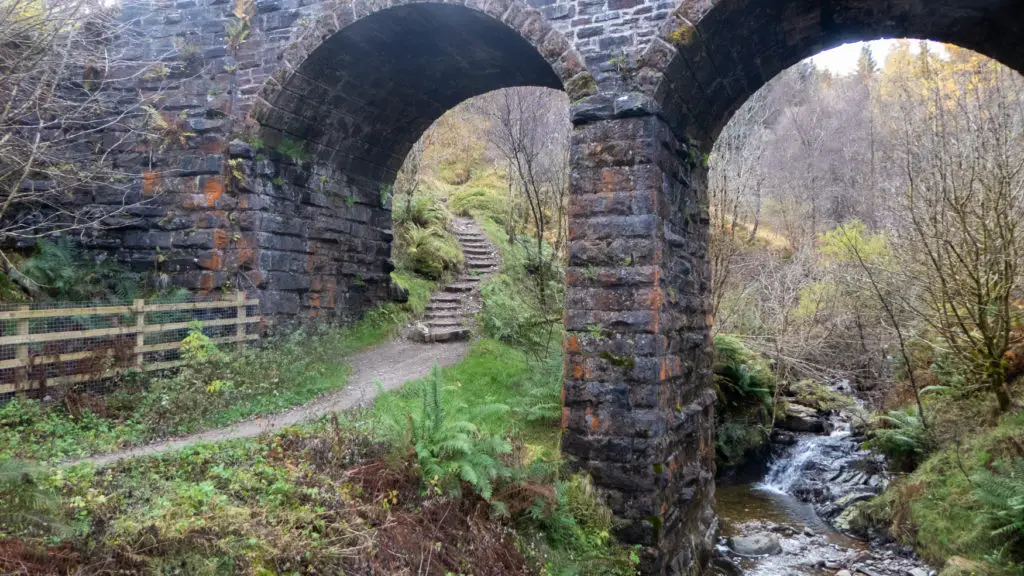
6 Day West Highland Way Itinerary
Day 1: Milngavie to Balmaha (19 miles)
- Difficulty: Easy
- Highlights: The starting point of the WHW in Milngavie, arriving in the countryside fresh from the city and the views from Conic Hill.
- Facilities: Accommodation is available in Milngavie, Drymen and Balmaha. Restaurants and shops are also available throughout this stage.
- Suggested accommodation: West Highland Way Rooms (Milngavie) & Birchwood Guest Lodge (Balmaha).
Day 2: Balmaha to Inveraran (21 miles)
- Difficulty: Challenging
- Highlights: Hiking around Loch Lomond and an optional detour to Rob Roy’s Cave.
- Facilities: Accommodation available at the Inversnaid Hotel and Inveraran. Refreshments available at both stops.
- Suggested accommodation: The Drovers Inn (Inveraran).
Day 3: Inverarnan to Tyndrum (12 miles)
- Difficulty: Moderate
- Highlights: Incredible mountain views and beautiful waterfalls. Falls of Falloch can just be glimpsed on the route.
- Facilities: Accommodation available at Inverarnan, Crianlarich and Tyndrum. Refreshments also available at these stops. Public toilets at Crianlarich and Tyndrum.
- Suggested accommodation: Tyndrum Lodges (Tyndrum).
Day 4: Tyndrum to Kingshouse (19 miles)
- Difficulty: Moderate
- Highlights: Mountain views, Rannoch Moor, Glencoe and possibility of spotting Red Deer.
- Facilities: Accommodation is available at Tyndrum, Bridge of Orchy, Inveroran and Kingshouse. Tyndrum is the last place to stock up on supplies for this stage. Refreshments are available at all of the accommodation stops however, choice is limited.
- Suggested accommodation: Kingshouse Hotel (Kingshouse).
Day 5: Kingshouse to Kinlochleven (9 miles)
- Difficulty: Moderate
- Highlights: Devil’s Staircase, mountain views and the highest point of the route.
- Facilities: Accommodation available at Kinlochleven including hotels and camping options. Shops and restaurants there, as well as a pub (yay)!
- Suggested accommodation: Blackwater Hostel (Kinlochleven).
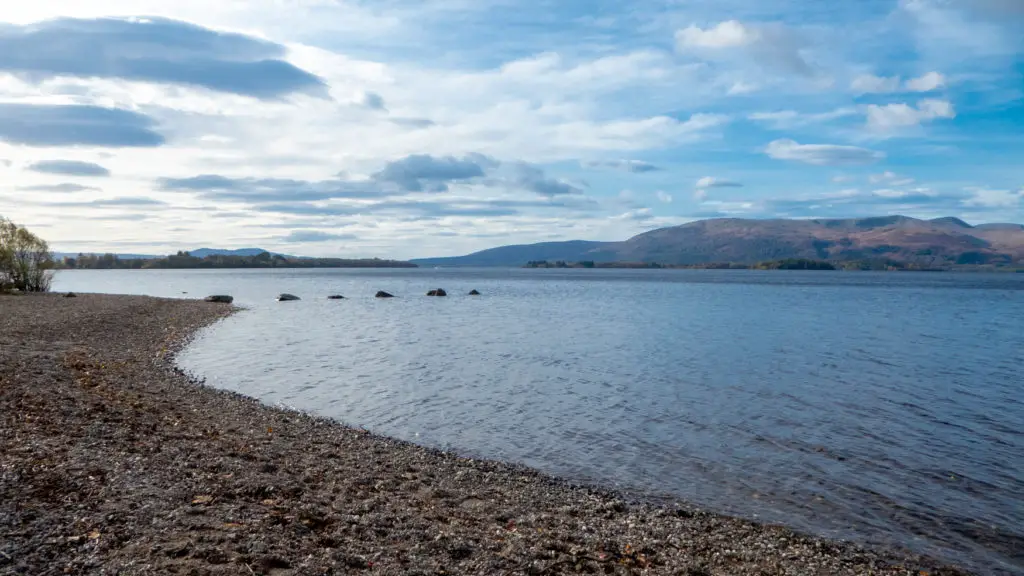
Day 6: Kinlochleven to Fort William (16 miles)
- Difficulty: Easy
- Highlights: Ruins at Tigh-na-sleubhaich, Ben Nevis and the finale of the West Highland Way in Fort William.
- Facilities: Various accommodation options available in Fort William to suit all budgets. Restaurants, shops and pubs in abundance!
- Suggested accommodation: Alexandra Hotel (Fort William).
7 Day West Highland Way Itinerary
Day 1: Milngavie to Drymen (12 miles)
- Difficulty: Easy
- Highlights: The starting point of the WHW in Milngavie, optional trip to Glengoyne Distillery.
- Facilities: Accommodation available in Milngavie and Drymen. Restaurants and shops in both places. Ad hoc honesty shops appear at fairly regular intervals on this stage of the hike.
- Suggested accommodation: West Highland Way Rooms (Milngavie) and Kip in the Kirk (Drymen).
Day 2: Drymen to Rowardennan (14 miles)
- Difficulty: Easy
- Highlights: Views from Conic Hill and Loch Lomond.
- Facilities: Accommodation is available in Balmaha and Rowardennan. This is also a good area for wild camping. Facilities in both of the above including a very cute pub called The Clansman. In Rowardennan
- Suggested accommodation: Rowardennan Youth Hostel (Rowardennan).
Day 3: Rowardennan to Inverarnan (14 miles)
- Difficulty: Challenging
- Highlights: Views over Loch Lomond and choice of a detour to Rob Roy’s Cave.
- Facilities: Accommodation spots at Inversnaid and Inverarnan. Refreshments are available at both of these places. There are also two MBA bothies located along this stage.
- Suggested accommodation: The Drovers Inn (Inveraran).
Day 4: Inverarnan to Tyndrum (12 miles)
- Difficulty: Moderate
- Highlights: Waterfalls close to Falloch Riber. The Falls of Falloch can just be seen and the surrounding mountain views are stunning.
- Facilities: Accommodation spots at Inverarnan, Crianlarich and Tyndrum. Refreshments also available here.
- Suggested accommodation: Tyndrum Lodges (Tyndrum).
Day 5: Tyndrum to Kingshouse (19 miles)
- Difficulty: Moderate
- Highlights: Rannoch Moor, wild Red Deer in the areas around Glencoe.
- Facilities: Accommodation at Tyndrum, Bridge of Orchy, Inveroran and Kingshouse. Tyndrum is the last spot to buy refreshments and snacks for the section ahead.
- Suggested accommodation: Kingshouse Hotel (Kingshouse).
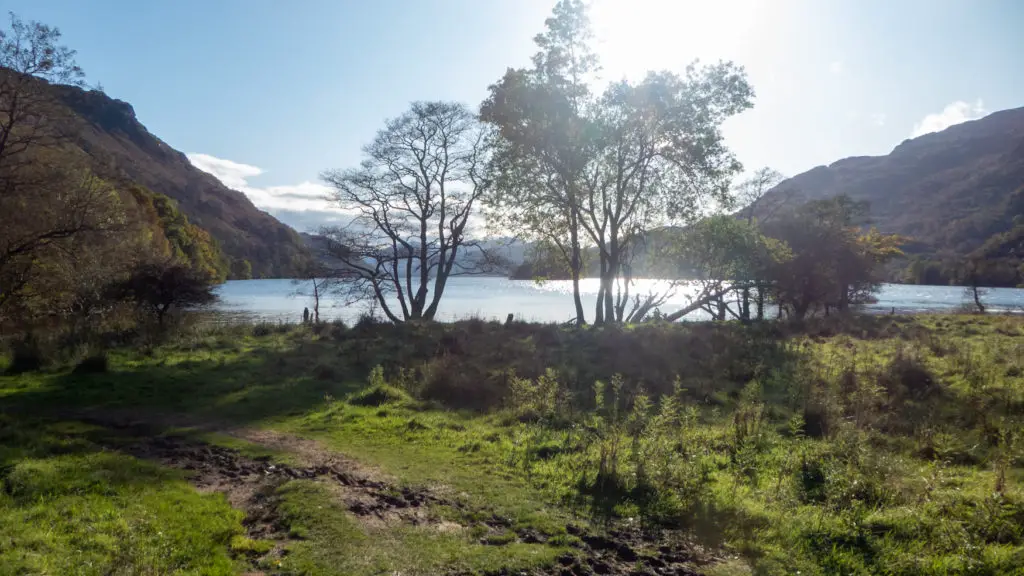
Day 6: Kingshouse to Kinlochleven (9 miles)
- Difficulty: Moderate
- Highlights: Devil’s Staircase and the highest point of the entire trail. The views are great in this area.
- Facilities: Accommodation at Kinlochleven with options to suit many budgets. There is a Co-Op here for stocking up on snacks for the final day.
- Suggested accommodation: Blackwater Hostel (Kinlochleven).
Day 7: Kinlochleven to Fort William (16 miles)
- Difficulty: Easy
- Highlights: Ruins at Tigh-na-sleubhaich (try pronouncing that after a beer!), Views of Ben Nevis and endpoint of the WHW in Fort William.
- Facilities: Plenty of accommodation in Fort William as well as pubs and restaurants.
- Suggested accommodation: Alexandra Hotel (Fort William).
8 Day West Highland Way Itinerary
Day 1: Milngavie to Drymen (12 miles)
- Difficulty: Easy
- Highlights: The starting point of the West Highland Way in Milngavie, optional detour to Glengoyne Distillery. When in Scotland, right…?!
- Facilities: Accommodation options in Milngavie and Drymen along with restaurants and shops.
- Suggested accommodation: West Highland Way Rooms (Milngavie) and Kip in the Kirk (Drymen).
Day 2: Drymen to Rowardennan (14 miles)
- Difficulty: Easy
- Highlights: Views from Conic Hill and Loch Lomond.
- Facilities: Accommodation options are available in Balmaha and Rowardennan. Places to eat in both villages although there is no shop in Rowardennan.
- Suggested accommodation: Rowardennan Youth Hostel (Rowardennan).
Day 3: Rowardennan to Inverarnan (14 miles)
- Difficulty: Challenging
- Highlights: Loch Lomond views and possible detour to Rob Roy’s Cave.
- Facilities: Accommodation spots at Inversnaid and Inverarnan. Refreshments are available at both of these places. There are also two MBA bothies located along this stage.
- Suggested accommodation: The Drovers Inn (Inveraran).
Day 4: Inverarnan to Tyndrum (12 miles)
- Difficulty: Moderate
- Highlights: Falls of Falloch can just be seen (cross the river for a better vantage point). The mountain views along this stretch of the trail are incredible.
- Facilities: Accommodation is available at Inverarnan, Crianlarich and Tyndrum. It is also possible to pick up refreshments and stock up on snacks in these places.
- Suggested accommodation: Tyndrum Lodges (Tyndrum).
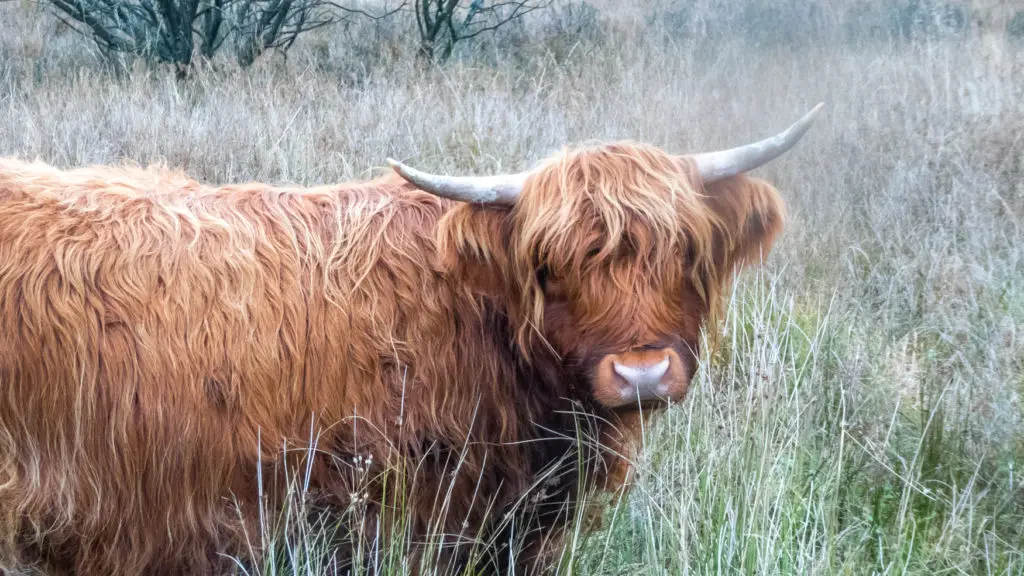 You may see the odd highland coo on your journey!
You may see the odd highland coo on your journey!Day 5: Tyndrum to Bridge of Orchy (7 miles)
- Difficulty: Easy
- Highlights: Views of Beinn Dorain and the West Highland Way train line. Make sure to wave at the train passengers!
- Facilities: Accommodation available in Tyndrum and Bridge of Orchy. Plenty of shops and restaurants in Tyndrum. Honesty box shop and restaurant at Bridge of Orchy.
- Suggested accommodation: Bridge of Orchy Hotel (Bridge of Orchy).
Day 6: Bridge of Orchy to Kingshouse (12 miles)
- Difficulty: Moderate (Rannoch Moor can be challenging in bad weather with poor visibility).
- Highlights: Rannoch Moor, Glencoe, Red Deer around Kingshouse.
- Facilities: Accommodation available at Inveronan and Kingshouse. No shops en route so make sure you purchase what you need in the upcoming days!
- Suggested accommodation: Kingshouse Hotel (Kingshouse).
Day 7: Kingshouse to Kinlochleven (9 miles)
- Difficulty: Moderate
- Highlights: Highest point on the trail and the dreaded Devil’s Staircase.
- Facilities: Accommodation at Kinlochleven. No facilities in between the start of this stage and the endpoint.
- Suggested accommodation: Blackwater Hostel (Kinlochleven).
Day 8: Kinlochleven to Fort William (16 miles)
- Difficulty: Easy
- Highlights: Tigh-na-sleubhaich ruins, Ben Nevis and finishing point of the West Highland Way.
- Facilities: Accommodation available in Fort William. Large supermarkets as well as several food and drink establishments.
- Suggested accommodation: Alexandra Hotel (Fort William).
Extending your West Highland Way Walk
All of the above West Highland Way itineraries can be extended to incorporate side trips along the way and extra adventures at the end. Many hikers enjoy taking a day trip to summit Ben Lomond and Ben Nevis. There is also the option to complete the West Highland Way and the Great Glen Way back to back. My feet were definitely not in a fit state for this challenge so the Great Glen Way is still sitting on the to-do list, waiting for my next Scottish adventure!

